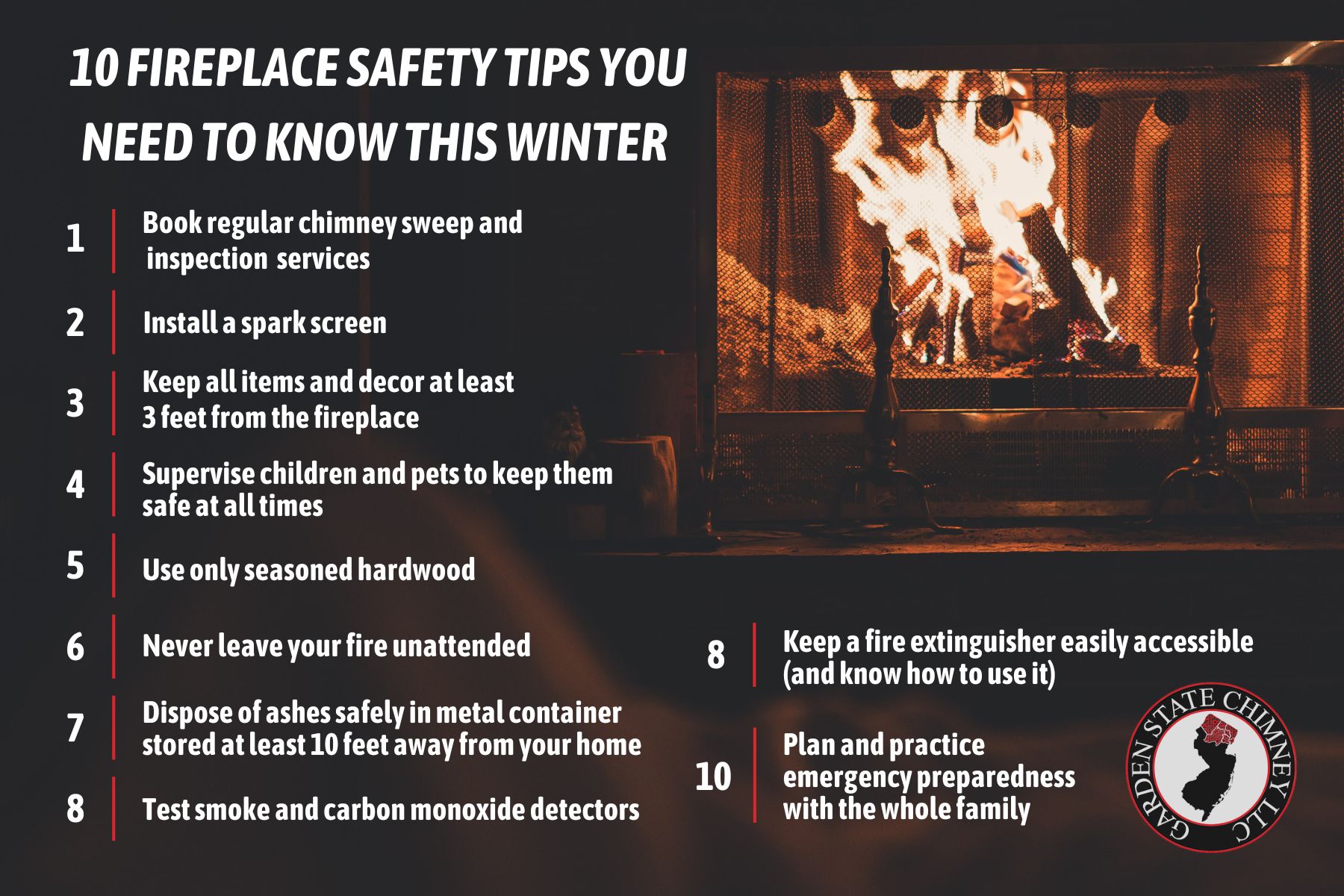The days are getting shorter, the nights are getting colder, and you have probably already begun cozying up next to the warm, crackling fire. Whether you’re unwinding after a long day, sharing stories with loved ones, or simply enjoying the quietude of a winter night, your fireplace serves as the heart of your home during these colder months. That said, don’t let the dancing flames distract you from the importance of fireplace safety. According to the National Fire Protection Association (NFPA), December, January, and February are the peak months for heat-related home fires to occur. While space heaters are most often involved in these events, fireplaces have definitely been known to play a role, as well.
Garden State Chimney doesn’t just take pride in providing residents around Wayne, NJ with superior chimney and fireplace services – we consider it our mission to ensure your winter is not only warmer and cozier, but enjoyed as safely as possible. We have created a list of the 10 best fireplace safety tips we think you need to know to keep your home and loved ones safer all season long.
Need to schedule a service with us? Call 321-CHIMNEY or book an appointment online.

1. Remember Routine Maintenance
Did you know it is recommended that you have your chimney and fireplace inspected and cleaned once a year? Sometimes, even more frequently, depending on how much you use your fireplace. Those guidelines are set in place by the Chimney Safety Institute of America (CSIA), a highly reputable industry leader known for certifying sweeps – including us! So it’s not only our job to follow these guidelines, but to make sure your fireplace is clear of any potential hazards and operating efficiently.
2. Install a Spark Screen
If you’ve ever sat around a popping campfire and gotten too close to witnessing a stray spark burn straight through your pants, then you’ll understand the importance of having a spark screen protect your home from the things your fireplace can produce. This is especially true if you enjoy decorating your mantel during the holiday season. Any flammable material nearby can spell disaster if a spark from the fireplace manages to escape.
3. Keep a Safe Distance
Keep all furniture and other flammable materials at least 3 feet from your fireplace or stove. This provides ample space for the radiant heat from the fire to dissipate, making it less likely nearby materials will catch on fire.
4. Use the Right Fuel
The only wood that should be used in your wood-burning fireplace is dry, seasoned hardwood. What that means is selecting wood that has been properly dried for an extended period of time (in most cases, at least 6 months). Seasoned hardwood burns more efficiently, producing less smoke and creosote buildup in your chimney. This should go without saying, but under no circumstances, should you use flammable liquids to start or accelerate the fire.
5. Supervise Children & Pets
Always keep a close eye on children and pets when the fireplace is in use. If need be, consider using safety gates or barriers to keep curious children and pets a safe distance from the fire. For older children, establish clear boundaries and reiterate the importance of responsible behavior around any flames.
6. Never Leave a Fire Unattended
Whether you’re calling it a night or simply just stepping away briefly, it’s extremely important to never leave a fire going unattended. Even a seemingly well-contained fire can spit out a loose ember or spark, potentially igniting nearby materials. It can happen faster than you think!
7. Dispose of Ashes Safely
Ash that is over an inch thick at the bottom of the fireplace can restrict air flow to the logs, thus producing more smoke (and, by consequence, more creosote). To maintain optimal airflow and prevent other potential issues from arising, dispose of cool ashes in a metal container with a tight fitting lid. These ashes should be stored outside, away from any combustible materials and at least 10 feet away from your home or any nearby buildings. Wait a few days before disposing of them properly.
8. Check Smoke & Carbon Monoxide Detectors
The smoke detectors and carbon monoxide detectors in your home should be tested at least once a month and have the batteries replaced every six months. That way, if there were an emergency, you’d be alerted quickly.
9. Keep Fire Extinguisher Nearby
Another way to be prepared in the event of fire is to always keep a fire extinguisher within easy reach of your fireplace. Choose an extinguisher that is rated for wood or paper fires (Class A) and familiarize yourself with how to use it properly. Having a fire extinguisher nearby helps provide a quick way to eliminate a small fire before it has a chance to escalate.
10. Plan & Practice Emergency Preparedness
We hope you never experience an event in which you have to carry out your emergency preparedness plan. However, if you have multiple people living in your house, it’s always a good idea to plan and practice how to respond in case a fire-related emergency arises. Establish clear evacuation routes, a designated meeting point, and practice these drills periodically.
Need a Chimney Sweep, Inspection, or Repair? Give Garden State Chimney a Call Today
Garden State Chimney is here to help with your routine maintenance needs. Sometimes, it doesn’t matter how prepared you are – the unexpected still occurs. If you find yourself in need of sudden chimney and fireplace repair services, we can help with that. Our team is committed to providing top notch service that exceeds your expectations.
Let us help you enjoy the warmth and coziness of your fireplace without worry. Give us a call today at 321-CHIMNEY or request an appointment on our website.
